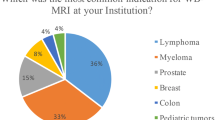Abstract
Objective
One prerequisite for transferring ultra-high-field magnetic resonance imaging (MRI) (>3T) into clinical diagnostic workup is a low rate of side effects. To our knowledge, publications of subjective acceptance and willingness to undergo examinations at >3T are rare. We present first results from our research site.
Materials and methods
Exposure to 7T whole-body MRI of head, extremities, or breast was assessed in 102 subjects. They judged sources of discomfort (examination duration, room temperature) and physiological sensations (vertigo, light flashes) on a 10-point scale, differentiating between examination phases: table stationary or moving. For comparison, the same questionnaire was completed by 43 of these subjects after undergoing a 1.5T examination. Vertigo was the most pronounced sensation at 7T with 5% rating it as very unpleasant (none at 1.5T). This should be compared with the fact that the lengthy exam duration was regarded as even more uncomfortable. Compared to 1.5T, average study duration at 7T was roughly doubled, and 7T elicited a wider range of complaints.
Conclusion
Although the number of side effects is increased at 7T compared to 1.5T, 7T was well tolerated by the majority of subjects. Further data collection is necessary for better understanding of these effects.
Similar content being viewed by others
References
Schild H (2005). Clinical highfield MR. Rofo 177: 621–631
Robitaille PM, Abduljalil AM, Kangarlu A, Zhang X, Yu Y, Burgess R, Bair S, Noa P, Yang L, Zhu H, Palmer B, Jiang Z, Chakeres DM and Spigos D (1998). Human magnetic resonance imaging at 8T. NMR Biomed 11: 263–265
Kangarlu A, Baudendistel KT, Heverhagen JT and Knopp MV (2004). Clinical high- and ultrahigh-field MR and its interaction with biological systems. Radiologe 44: 19–30
International Electrotechnical Commission (2002) Medical electrical equipment—Part 2–3: Particular requirements for the safety of magnetic resonance equipment for medical diagnosis. IEC 60601-2-33
United States Food and Drug Administration (2003) Guidance for industry and FDA staff: criteria for significant risk investigations of magnetic resonance diagnostic devices
Kangarlu A and Robitaille P (2000). Biological effects and health implications in magnetic resonance imaging. Concepts Magn Reson 12: 321–359
Tenforde TS (1992). Biological interactions and potential health effects of extremely-low-frequency magnetic fields from power lines and other common sources. Annu Rev Public Health 13: 173–196
Saunders R, Orr J (1983) Biological effects of NMR. In: Partain C, James A, Rollo F, Price R (eds) Nuclear magnetic resonance imaging. Philadelphia, pp 383–396
Colletti PM (2004). Size “H-oxygen cylinder: accidental MR projectile at 1.5 Tesla. J Magn Reson Imaging 19: 141–143
Chaljub G, Kramer LA, Johnson RF 3rd, Johnson RF Jr, Singh H, and Crow WN (2001). Projectile cylinder accidents resulting from the presence of ferromagnetic nitrous oxide or oxygen tanks in the MR suite. AJR Am J Roentgenol 177: 27–30
de Vocht F, Stevens T, Glover P, Sunderland A, Gowland P and Kromhout H (2007). Cognitive effects of head-movements in stray fields generated by a 7 Tesla whole-body MRI magnet. Bioelectromagnetics 28: 247–255
Glover PM, Cavin I, Qian W, Bowtell R and Gowland PA (2007). Magnetic-field-induced vertigo: a theoretical and experimental investigation. Bioelectromagnetics 28: 349–361
Schenck JF (2005). Physical interactions of static magnetic fields with living tissues. Prog Biophys Mol Biol 87: 185–204
Chakeres DW and deVocht F (2005). Static magnetic field effects on human subjects related to magnetic resonance imaging systems. Prog Biophys Mol Biol 87: 255–265
Chakeres DW, Bornstein R and Kangarlu A (2003). Randomized comparison of cognitive function in humans at 0 and 8 Tesla. J Magn Reson Imaging 18: 342–345
Chakeres DW, Kangarlu A, Boudoulas H and Young DC (2003). Effect of static magnetic field exposure of up to 8 Tesla on sequential human vital sign measurements. J Magn Reson Imaging 18: 346–352
Schenck JF (2000). Safety of strong, static magnetic fields. J Magn Reson Imaging 12: 2–19
McRobbie D and Foster MA (1984). Thresholds for biological effects of time-varying magnetic fields. Clin Phys Physiol Meas 5: 67–78
Schenck JF, Dumoulin CL, Redington RW, Kressel HY, Elliott RT and McDougall IL (1992). Human exposure to 4.0-Tesla magnetic fields in a whole-body scanner. Med Phys 19: 1089–1098
Official Journal of the European Union (2004) Directive 2004/40/EC of the European Parliament and of the Council
Vogt FM, Ladd ME, Hunold P, Mateiescu S, Hebrank FX, Zhang A, Debatin JF and Gohde SC (2004). Increased time rate of change of gradient fields: effect on peripheral nerve stimulation at clinical MR imaging. Radiology 233: 548–554
Cavin ID, Glover PM, Bowtell RW, Gowland PA (2006) Thresholds for perceiving a metallic taste at large magnetic field. In: Proceedings of internatinal society for magnetic resonance in medicine, vol 14. Seatle, pp 2052
König C, Klöppel R (2007) How can patient education provoke temporary contrast agent sensations? (Inwieweit kann ärztliche Aufklärung temporäre Kontrastmittelsensationen provozieren?)]. In: DRK, Berlin
Author information
Authors and Affiliations
Corresponding author
Rights and permissions
About this article
Cite this article
Theysohn, J.M., Maderwald, S., Kraff, O. et al. Subjective acceptance of 7 Tesla MRI for human imaging. Magn Reson Mater Phy 21, 63 (2008). https://doi.org/10.1007/s10334-007-0095-x
Received:
Revised:
Accepted:
Published:
DOI: https://doi.org/10.1007/s10334-007-0095-x




